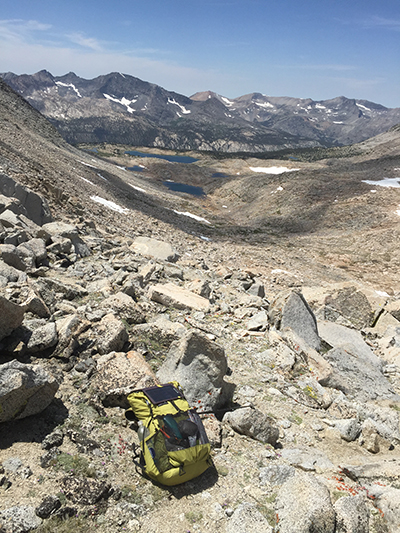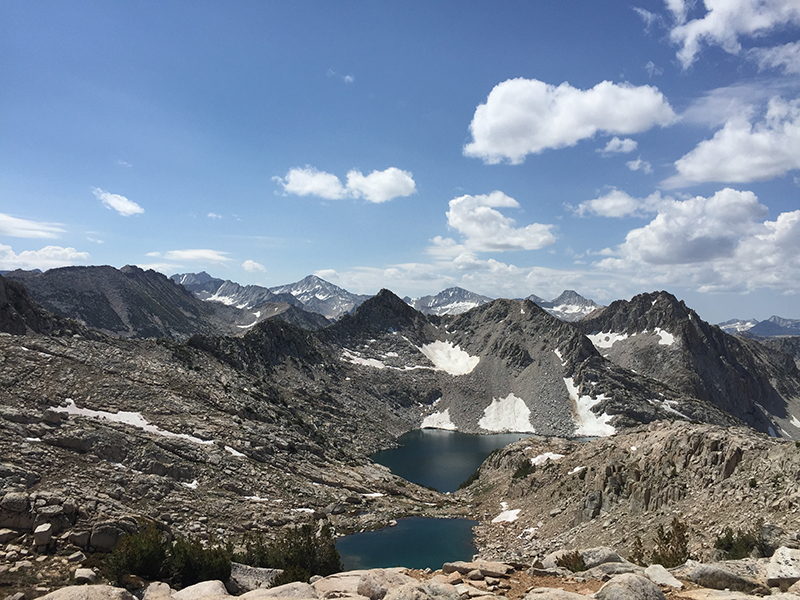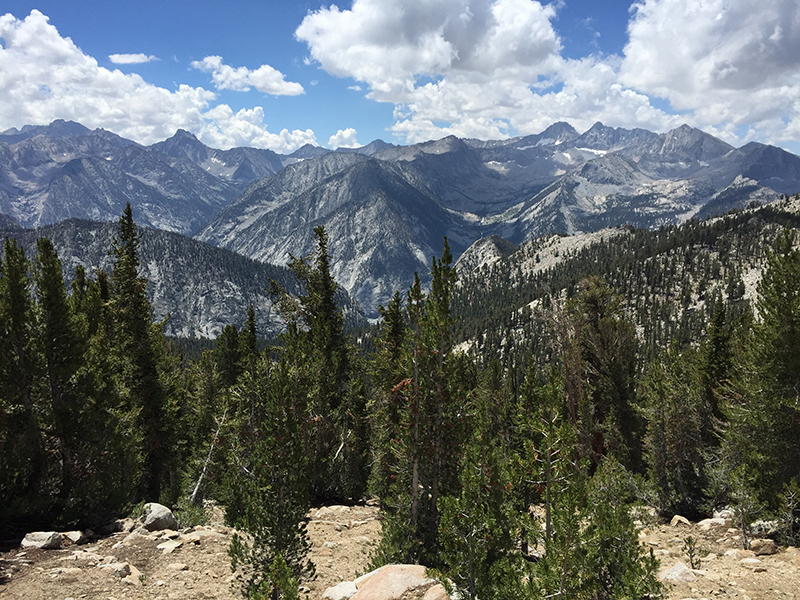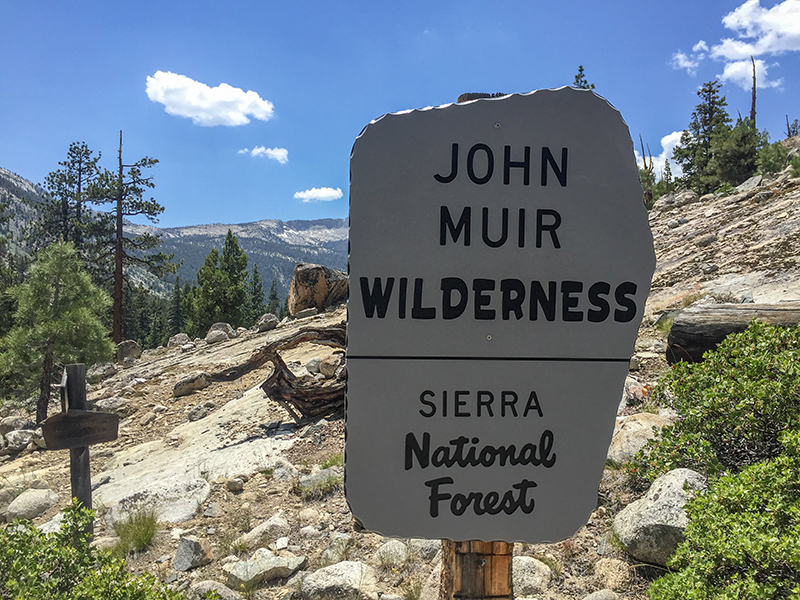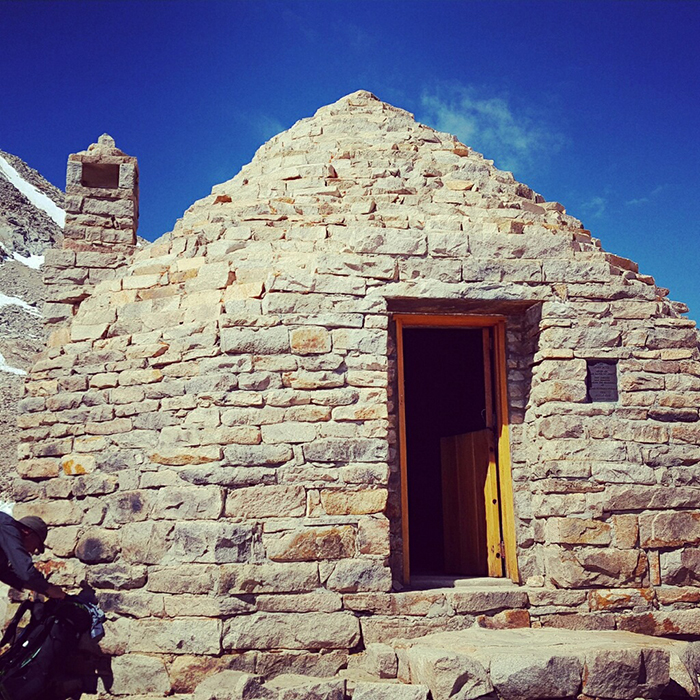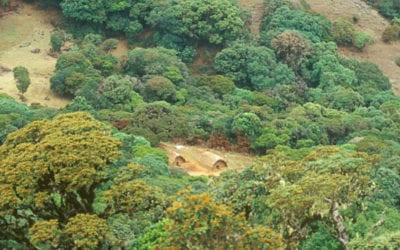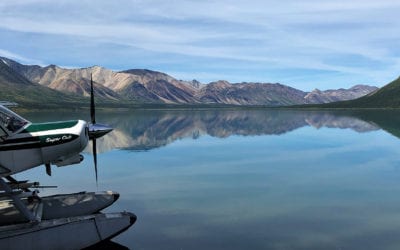Reflections and clarity in the Sierra Nevadas. Photo credit © Brian Peterson
Wilderness Trails: Influences of Perceptions
Soul of the Wilderness
April 2020 | Volume 26, Number 1
Trails don’t have a voice, but they tell numerous stories as they guide recreationists through wilderness. But, trails may influence unrealistic wilderness perceptions and may decrease autonomy, which could affect wilderness values. The purpose of this article is to draw attention to the effect trail usage may have on recreationists’ wilderness perspectives and to explore how these perspectives may affect perceptions of autonomy, and possible relations to societal benefits.
This inquiry developed while conducting research to investigate how trail conditions along the Appalachian Trail (AT) affected experiences of long-distance hikers (Peterson, Brownlee, and Marion 2018). Although that research was insightful about relationships between trail conditions and experiential elements, it didn’t investigate how trails affected recreationists’ wilderness perspectives. Of specific interest were the following questions: How do trails shape recreationists’ experiences? How do trails affect the “unconfined” values of wilderness? And how do trails affect perceptions of autonomy?
To gain an understanding into the complexities of these questions I investigated my perceptions of on-trail backpacking versus off-trail backpacking during an extended trip in the Sierra Nevada mountain range in California. This area is home to Yosemite National Park, Kings Canyon National Park, Sequoia National Park, Devils Postpile National Monument, and 20 designated wilderness areas. Elevations range from 1,360 feet (415 m) to 14,494 (4,418 m) feet at the top of Mount Whitney, the highest peak in the contiguous United States (National Park Service 2018).
The Trip
One year after conducting research along the AT, I engaged in a personal trek in which I backpacked from Yosemite National Park to Kings Canyon National Park. Before this trip, all of my backpacking experiences had been on trails. My goals were to stay within federally designated wilderness, primarily travel away from trails (where permitted and appropriate), and to also use trails at irregular intervals to see how they influenced my experiences. By backpacking both on trails and off trails within the same trip I would be able to immediately make comparisons of my experiences.
My route covered about 200 (322 km) miles with approximately 150 miles (241 km) of off-trail backpacking. The 50 miles (80 km) of trails were sprinkled into my itinerary at sporadic intervals. For the entirety of the 200 miles I navigated using maps and a compass. I carried a GPS unit but never used it. It was important to not use the GPS unit as a constant guide in which I would follow a digital trail. I wanted to immerse myself into off-trail backpacking to understand on-trail backpacking. I felt that the contrasting experiences of hiking on trails and off trails would help me understand how trails influence my perceptions.
The following sections describe significant experiences and perceptions I had while backpacking on trails and off trails. These experiences and perceptions are then discussed in relation to autonomy. Autonomy is seen in actions that are freely undertaken. These actions don’t feel pressured by external forces and are rationally endorsed by the individual (Deci and Ryan 2013).
Perspectives
As the trip approached, I could feel anxiety pulsating through my blood any time I thought about backpacking off trail. This wasn’t a small step into off-trail backpacking, I was leaping into 150 miles (80 km) of off-trail backpacking. Naturally my pretrip cognitions were in overdrive. I had never felt these sensations when an on-trail backpacking trip was due soon to commence. Going backpacking off trail already felt like going into the unknown. I assumed that off-trail backpacking would be harder, deliver more solitude, and affect a multitude of my wilderness perceptions. Thank goodness we are lucky enough to have places to do this, a place where I could conduct a personal study to understand my perceptions of on trail versus off trail. Once the trip was under way, I noticed immediate differences.
After miles of slogging off trail, there was a noticeable shift in my experience when I cruised on trail. Trails provide easier passage not nearly as frustrating as backpacking off trail. Backpacking off trail is an extremely tedious task, especially when it involves backpacking 150 miles (80 km) through terrain with constant obstacles such as boulders, trees, bushes, and dangerous river crossings. Each step of backpacking off trail required immense focus, which was extremely exhausting both physically and mentally. This high level of challenge and the required focus exhausted my mental state and prevented me from fully enjoying the surrounding wilderness. I felt that my mind was constantly depleted due to the mental focus needed to traverse technical off-trail terrain. My mental exhaustion was further exacerbated because of the cognitive energy needed to navigate with maps and a compass. The combination of these two took a lot out of me mentally. Using a GPS would have certainly made things easier, but it wouldn’t have been as pure a personal study had I followed a digital trail. In comparison, backpacking on trail felt glorious, providing less resistance, allowing more time to look around, and my sense of belonging felt heightened because I wasn’t as drained. Trails grounded me by showing me that I was exactly where I wanted to be while being able to enjoy the wilderness surroundings.
On-trail backpacking was less exhausting. I found that my mind was more receptive to awe-inspiring experiences because it wasn’t constantly fatigued. When I was exhausted, I felt confined and less autonomous, and instead of feeling like I was freely making choices, I instead felt confined. This exhausted and confined mental state was certainly a bit at odds with the unconfined aspect of wilderness values. For example, I noticed that at beautiful on-trail vistas there was a harmonious camaraderie amongst hikers reveling in awe. People were happy, conversational, and amiable. In contrast, while backpacking off trail my mind felt unreceptive to awe; I was just too exhausted to process my surroundings. Oddly, while off trail I took less advantage of the enjoyment of vistas. I became more focused on getting myself recovered for the next few miles instead of absorbing the benefits of wilderness.
Although on-trail backpacking felt less confining because the same level of exhaustion wasn’t a factor, my autonomy concurrently also felt diminished. This was an interesting conflict: exhaustion wasn’t confining my mind while on trail, yet trails had aspects too that made me feel less autonomous. While on trail I felt like I had lost my off-trail freedom; I felt my freedom of choice was gone. Until these off-trail experiences, I had never thought about how uncompromising trails are: trails told me exactly where to go! While backpacking on trails, I no longer could creatively choose where to go, as I was now confined to a narrow corridor. This recognition immediately affected my perceptions of autonomy.
It soon became apparent that this personal investigation of trail perceptions had more complexity than what I had anticipated: trails boosted my autonomy (less mental fatigue) while simultaneously diminishing my autonomy (trails uncompromisingly told me where to go). This complexity prompted me to compare the magnitude of these factors. When I had less mental exhaustion, my autonomy felt high. When trails told me where to go, I barely noticed any effect on my autonomy. I wondered – why did this differential matter? It seemed to me that trails are a normalized attribute of wilderness, and most wilderness users rationally endorse using them and thus don’t notice any diminishment in autonomy. Thus far, I had analyzed mental exhaustion, and the uncompromising nature of trails. But I felt that I was missing connections between trails and societal effects.
I was surprised to find that trails boosted social relations. Happy groups of people at vistas appeared connected and were enjoying being around others – a satisfaction that trails provided access to. The more I thought about it, the more I concluded that it seemed people didn’t care at all about trails telling them where to go. Trails are so normalized that the slight extrinsic factor of being guided to locations didn’t appear to matter. And as groups at vistas showed me, having a connection to others felt good. However, on the contrary, I was surprised to find that I had become sensitive toward crowded conditions while backpacking on trail. After trekking for miles off trail without seeing another person, the social conditions of backpacking on trail felt overwhelming. I was surprised to feel crowded! Rarely in the past had I felt crowded while backpacking on trail. My on-trail experiences were additionally devalued thanks to my off-trail experiences. I was now seeing trailside impacts with a fresh set of eyes recalibrated from traveling off trail. But again I was feeling conflicted. Trails impressed me with their ability to boost social relations. Yet off-trail experiences retrained me to become pedantic toward crowding and trailside impacts. To understand how trails affected my wilderness perceptions, I continued along on my physical (and mental) trek.
My perceptions of safety were also different when I backpacked on trails. There I felt safer because I knew I was connected along a cleared path to services outside of the wilderness. To understand safety, I questioned why I liked to backpack. One of those answers was to get away from the comforts of society, and to cherish time away from societal pressures and influences. The ideal of being safe is great, but when I thought about it, it actually felt nice to introduce aspects of risk into my life – in fact it was invigorating. I recognized that I often put a lot of value in safety nets, but they can have a confining effect, diminishing autonomy because I feel compelled to maintain proximity to them. Maybe safety nets make my life a bit too sanitized, maybe too comfortable and less wild. Maybe this perception of safety associated with trails had helped entice me in the past to backpack on trails, but it was actually a confining perception.
I was feeling as if I was trekking deeper into a mental off-trail zone where my maps and compass provided no navigational help. I put my focus into the history of wilderness. All trails have a historical component and were created for a reason. A trail I trekked along during this trip was the iconic John Muir Trail (JMT), which weaves through Yosemite National Park, Kings Canyon National Park, and Sequoia National Park. The JMT has roots in early exploration of the area and is now one of the most popular trails to backpack in the United States. During my trek I had hiked over Muir Pass, which is the location of the famous John Muir Hut, an emergency shelter at 11,955 feet (3,644 m). The Muir Hut is a beautiful octagonal granite dome that blends into the above-tree-line vast granite landscape. This shelter is also a popular location to take a hiking break that provides the opportunity to revel in the history emanating from the shelter. Within the shelter a historical plaque commemorating John Muir connects backpackers to Muir’s conservation efforts that helped get the area designated as wilderness. The Muir Hut explicitly showed me that trails have a strong historical connection.
At the Muir Hut I enjoyed an immediate connection to John Muir and the many gracious others who contributed to making this area a designated wilderness. I was then prompted to recognize the arduous efforts so many people have made to ensure wilderness designations. The Muir Hut was humbling and richly reminded me how lucky I am to partake in my adventure of privileged exploration in a protected wilderness area. It also concretely signified that I am connected to others and to society.
Seeing the Muir Hut blend into the landscape along with feeling the historical component of wilderness shook up my perceptions of autonomy. Up until this point I had failed to make the connection between personal autonomy and social responsibility. Thanks to the Muir Hut I now realized that for the whole trip I had been unknowingly submerged in social responsibility and social values; they had just been blending into the landscape. After all, I had been hiking through socially constructed areas featuring socially constructed values without recognizing the historical component of trails and their societal benefit. Just as the Muir Hut had a plaque commemorating John Muir, wilderness trails are a plaque commemorating wilderness access, the benefits wilderness has to offer, and the efforts of countless people who have graciously contributed to wilderness areas. It became obvious to me that others had reveled in these areas, and that they wanted others to also have access to the benefits of wilderness. As I began to process the social aspects of these areas, my gratitude quickly rose up, and I felt astonished that others offered their assurance that (when willing) I could benefit from these areas as well.
Journey’s End
Perceptions shape how wilderness is viewed, and trails definitely are an influential factor. Trails told me where to go and made wilderness travel easier. However, trails minimized options of places to explore and reduced the possibility to creatively travel through the landscape. Trails often promote crowded conditions and can disengage people from tangibly understanding how frustrating wilderness travel can be. But trails also taught me about social responsibility. Trails may slightly diminish my personal autonomy, but this is fine with me because it’s for the greater good. Wilderness areas may not be perfect, and there may be some rules, but without a doubt they benefit society, and it is imperative that society can access those benefits. Trails are a perfect guide leading people to those benefits. The stories trails tell are not limited to ease of travel, guidance, and history. Trails provide access into wilderness resulting in a plethora of benefits for recreationists, which extend to societal benefits. These benefits are a significant part of the core reason why wilderness areas exist. Wilderness areas are a social responsibility and trails are the linkage to the benefits wilderness holds.
Returning home from my trip, I nostalgically thought about the new stories that trails had told me. Trails will always have a place in my heart. Depending on what type of experiential outcome I am seeking, I choose whether to use trails or to go off trail. Similarly, people enter wilderness with desired experiential outcomes, and typically those experiences involve trails. Most wilderness users seek to get to a destination by trails, and trails provide access to that experience. Using trails feels satisfying because they are the means to achieving an experiential goal. And along the way people just may get a boost in social relations when a group falls silent to revel in awe. It is easy to find a picture on social media of someone in wilderness standing on a trail with a big smile. It is that awareness of other people’s benefits that boosts my happiness, which leaves me wondering how far-reaching the benefits of wilderness are on society. It would be unfair if wilderness was trail-less, because these benefits would be too difficult for most to access. Trails do just that: provide access. As simplistic as that statement is, it is embedded with a network of connections and experiential outcomes that without trails would be too difficult to access, which contradicts the social responsibility of wilderness. Thanks to trails, I’ve now been influenced to see the social responsibility of wilderness. Once again, trails provided access.
BRIAN PETERSON is a project coordinator and doctoral research assistant in the Park Solutions Lab at Clemson University; email: bpeter6@g.clemson.edu.
References
Deci, E. L., and R. M. Ryan. 2013. The importance of autonomy for development and well-being. In B. W. Sokol, F. M. E. Grouzet, and U. Muller (Eds.) Self-Regulation and Autonomy: Social and Developmental Dimensions of Human Conduct (pp. 19–46). Cambridge, England: Cambridge University Press.
National Park Service. 2018. Sierra Nevada Inventory and Monitoring Network. https://www.nps.gov/im/sien/parks-partners.htm.
Peterson, B. A., M. T. Brownlee, and J. L. Marion. 2018. Mapping the relationships between trail conditions and experiential elements of long-distance hiking. Landscape and Urban Planning 180: 60–75.
Read Next
Of Global Concern: Reliance upon Resilience
There is no argument that the Australia bushfires are of global concern, but what may be of more concern is the lack of a greater resonance across the globe. If nature can no longer react and response to threats, then nature must rely upon us.
The Toda People: Stewards of Wilderness and Biodiversity
At a period when humankind appears to be so disconnected with nature that they assume their species can survive without respecting other forms of life, it might be pertinent to see how a traditional Toda mind is trained to interact with nature.
Social Media Data in Remote and Low-Use Backcountry Areas: Applications and Limitations
This article evaluates data from user-generated content related to two national parks in Alaska. One season of Twitter and Flickr posts was collected, coded for content, and mapped if geographic data was available.


